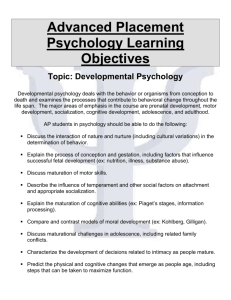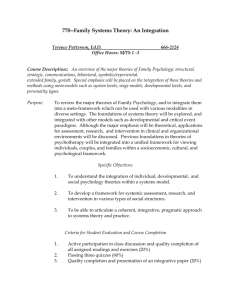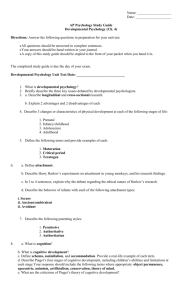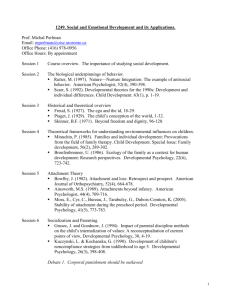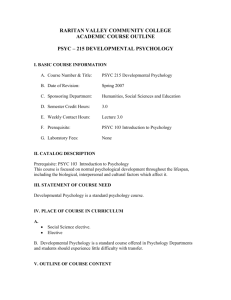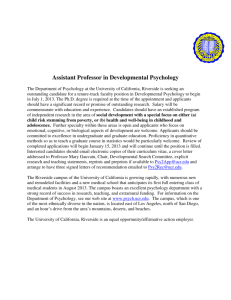EDG 610 Syllabus of Record
advertisement
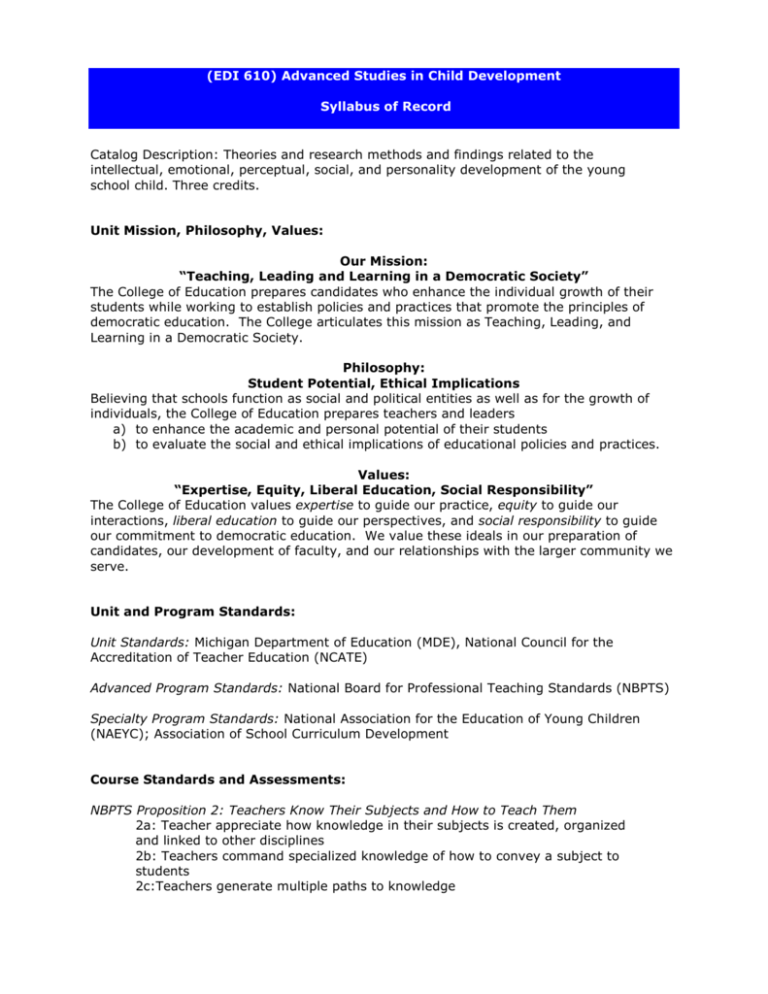
(EDI 610) Advanced Studies in Child Development Syllabus of Record Catalog Description: Theories and research methods and findings related to the intellectual, emotional, perceptual, social, and personality development of the young school child. Three credits. Unit Mission, Philosophy, Values: Our Mission: “Teaching, Leading and Learning in a Democratic Society” The College of Education prepares candidates who enhance the individual growth of their students while working to establish policies and practices that promote the principles of democratic education. The College articulates this mission as Teaching, Leading, and Learning in a Democratic Society. Philosophy: Student Potential, Ethical Implications Believing that schools function as social and political entities as well as for the growth of individuals, the College of Education prepares teachers and leaders a) to enhance the academic and personal potential of their students b) to evaluate the social and ethical implications of educational policies and practices. Values: “Expertise, Equity, Liberal Education, Social Responsibility” The College of Education values expertise to guide our practice, equity to guide our interactions, liberal education to guide our perspectives, and social responsibility to guide our commitment to democratic education. We value these ideals in our preparation of candidates, our development of faculty, and our relationships with the larger community we serve. Unit and Program Standards: Unit Standards: Michigan Department of Education (MDE), National Council for the Accreditation of Teacher Education (NCATE) Advanced Program Standards: National Board for Professional Teaching Standards (NBPTS) Specialty Program Standards: National Association for the Education of Young Children (NAEYC); Association of School Curriculum Development Course Standards and Assessments: NBPTS Proposition 2: Teachers Know Their Subjects and How to Teach Them 2a: Teacher appreciate how knowledge in their subjects is created, organized and linked to other disciplines 2b: Teachers command specialized knowledge of how to convey a subject to students 2c:Teachers generate multiple paths to knowledge Common Course Assessment: Developmental Guide Major Topics: Major theoretical notions of human development across the lifespan Human development theories and their applications Interface between the major theories and current research Evaluate the major human development theories and their applications Primary literature relevant to the study of human development Scope and sequence of the developmental stages, birth through age eight Ecological perspectives of child growth and development Cultural differences in various cultural settings and their impact on child growth and development Knowledge Base Ainsworth, M. D. S., & Bowlby, J. (1991). An ethological approach to personality development. American Psychologist, 46, 333-341. Ainsworth, M., Blehar, M., Waters, E., Wall, S. (1978). Patterns of attachment. Hillsdale, NJ: Lawrence: Erlbaum Press. Ainsworth, M.D.S. (1989). Attachments beyond infancy. American Psychologist, 44, 709716. Arnett, J.J. (2000). Emerging adulthood: Theory of development from late teens through the twenties. American Psychologist, 55, 469 Baltes, P.B. (1987). Theoretical propositions of life-span developmental psychology: On the dynamics of growth and decline. Developmental Psychology, 23, 611-626. Bandura, A. (1997). Social Cognitive Theory. Annals of Child Development, 6, 1 – 60. Beilin, H. (1992). Piaget’s enduring contribution to developmental psychology. Developmental Psychology, 28, 191 – 204. Belsky, J., Steinberg, L., & Draper, P. (1991). Childhood experience, interpersonal development, and reproductive strategy: An evolutionary theory of socialization. Child Development, 62, 647 – 670. Bjorklund, D. F. & Pellegrini, A. D. (2000). Child development and evolutionary psychology. Child Development, 71, 1687 – 1708. Brooks-Gunn, G. Duncan, & J.L. Aber (Eds.) Neighborhood poverty: Policy implications in studying neighborhoods. New York: Sage. Brown, B. The role of peer groups in adolescents’ adjustment to secondary school. In T.J. Berndt & G. W. Ladd (1989). Peer relationships in child development. New York: Wiley. Bruner, J. (1966). Studies in cognitive growth: collaboration at the Center for Cognitive Studies. New York: Wiley & Sons. Bruner, J. (1974). Toward a theory of instruction. Cambridge: Harvard University Press. Burton, L., Price-Spratlen, & Beale-Spencer, M. (1997). On ways of thinking about measuring neighborhoods: Implications for studying context and developmental outcomes for children. Charlesworth, W. R. (1997). Darwin and developmental psychology: Past and present. Development Psychologist, 28, 5 – 16. Collins, W. A., Maccoby, E. E., Steinberg, L., Hetherington, E. M., & Bornstein, M.S., (2000). Contemporary research on parenting: The case for nature and nurture. American Psychologist, 55, 218 – 232. Crain, W. (2000). Early theories.(ch. 1). Theories of Development, 4th edition. Englewood Cliffs, NJ: Prentice Hall. Dewey, J. (1997). Experience and education. New York: MacMillan Publishing Co. Dewey, J. (1997). How we think. New York: Dover Publications. Elder, G. (1998). The life course as developmental theory. Child Development, 69, 1 – 12. Flavell, J.H. (1992). Cognitive development: Past, present, and future. Developmental Psychology, 28, 998 –1005. Fogel, A., & Thelen, E. (1997). Development of early expressive and communicative action: Reinterpreting the evidence from a dynamic systems perspective. Developmental Psychology, 23, 747-761. Gauvain, M. (2001). The social context of cognitive development. New York: Guildford. Pp.19 – 63. Gewirtz, J.L., & Pelaez-Nogueras, M. (1992). B.F. Skinner’s legacy to human infant behavior and development. American Psychologist, 47, 1411-1422. Glick, J.A. (1992). Werner’s relevance for contemporary developmental psychology. Developmental Psychology, 28, 558 – 565. Goldhaber, D. E. (2000). Prologue: Theories of human development: Integrative Perspectives. Mountain View, CA: Mayfield. Graber, J.A., & Brooks-Gunn, J. (1996). Transitions and turning points: Navigating the passage from childhood through adolescence. Developmental Psychology, 32, 768 – 776. Grusec, J. E. (1992). Social learning theory and developmental psychology: The legacies of Robert Sears and Albert Bandura. Developmental Psychology, 28, 776-786. Hamer, D. (1997). The search for personality genes: Adventures of a molecular biologist. Current Directions in Psychological Science, 6, 111-114. Harkness, S. (2002). Culture and social development: Explanations and evidence. In P.Smith & C. Hart (Eds.). Blackwell handbook of childhood social development. Malden, MA: Blackwell Press. Harris, J. (1995). Where is the child’s environment? A group socialization theory of development. Psychological Review, 10, 458 - 489. Hinde, R. A. (1991). When is an evolutionary approach useful? Child Development, 62, 671 – 675. Kagan, J., & Snidman, N. (1991). Temperamental factors in human development. American Psychologist, 46, 856-862. Lerner, R (2002), Concepts and theories of human development. New York: Random House Lewis, M. D. (2000). The promise of dynamic systems approaches for an integrated account ofhuman development. Child Development, 71, 36-43. Luthar, S., Cicchetti, D., & Becker, B. (2000). The construct of resilience: evaluation and guidelines for future work. Child Development, 71, 543 – 562. A critical Masten, A. S. (2001). Ordinary magic: Resilience processes in development. American Psychologist, 56, 227 – 238. McLoyd, V. C. (1998). Socioeconomic disadvantage and child development. American Psychologist, 53, 185 – 204. Miller, P. (1993). Theories of developmental psychology, (3rd Ed.) (pp. 2-27). NY: Freeman. Neisser, U. (1967) Cognitive psychology. New York: Appleton-Century Crofts. Panksepp, J. (1998). Attention deficit hyperactivity disorders, psycho stimulants, and intolerance of childhood playfulness: A tragedy in the making? Current Directions in Psychological Science, 7, 91-98. Piaget, J. (1972). The psychology of the child. New York: Basic Books. Piaget, J. (1990). The child’s conception of the world. New York: Littlefield Adams. Pike, A. (2002). Behavioral genetics, shared and nonshared environment. In P.Smith & C. Hart (Eds.).Blackwell handbook of childhood social development. Malden, MA: Blackwell Press. Scarr, S. (1992). Developmental theories for the 1990s: Development and individual differences. Child Development, 63, 1-19. Sigler, R. S. (1991). Information-processing theories of development. Children’s Thinking (ch. 3, pp. 6291). Englewood Cliffs, NJ: Prentice Hall. Stewart, A. & Healy, J. (1989). Linking individual development and social change. American Psychologist, 44, 30-42. Thelen, E. (1992). Development as a dynamic system. Current Directions in Psychological Science, 1, 189-193. Thomas, R. (2000). Comparing theories of child development. Belmont, CA: Wadsworth Publishing Co. Vygotsky, L. (1986). Thought and language. Boston: MIT Press. Waters, E., & Cummings, E. M. (2000). A secure base from which to explore close relationships. Child Development, 71, 164-173. Weisner, T. S. (2002). Ecocultural understanding of children’s developmental pathways. Human Development, 45, 275 – 281. Wertsch, J.V., & Tulviste, P. (1992). L.S. Vygotsky and contemporary developmental psychology, Developmental Psychology, 28, 548 – 557.
